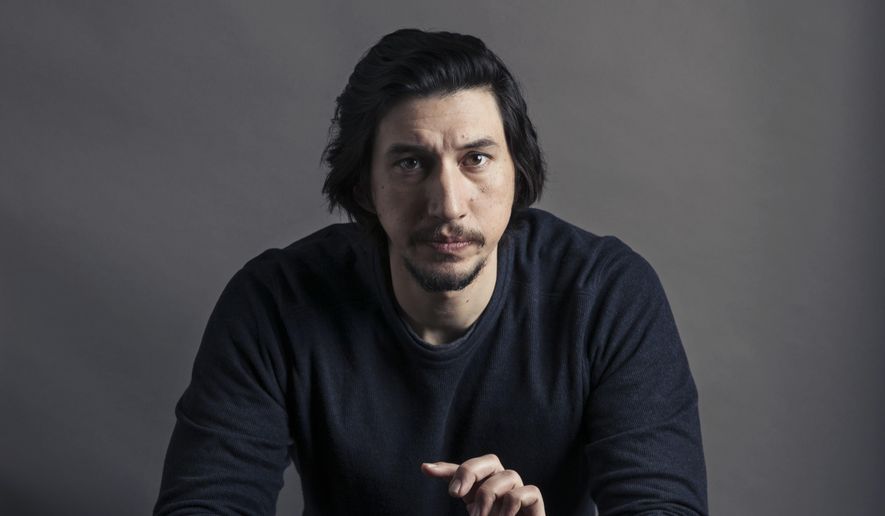NEW YORK (AP) - Adam Driver prefers not to see the films and TV shows he’s in, a policy that he grants he’s taken a little far.
“I haven’t seen ’Lincoln’ and I have, like, the smallest part in ’Lincoln,’ Driver says, chuckling. “It’s not called ’Samuel Beckwith the Telegraph Operator,’ it’s called … ’Lincoln.’ I should watch it.”
Even though he stars in two of the better films of the year, Jim Jarmusch’s “Paterson” and Martin Scorsese’s “Silence,” Driver won’t see either. It’s too excruciating.
“I try not to because I’ve seen things I’ve been in before and it’s terrible,” says Driver. “I think it’s bad and it’s film and film is forever. I want to change things. I kind of drive myself nuts and everyone around me nuts. It’s mostly about control. You really have no control, so I try to surrender it.”
Driver’s attitude isn’t uncommon among performers, but it hints at what distinguishes him as an actor. For him, it’s about the experience of building a role, inhabiting it and then letting it go. To play the poet-bus driver of “Paterson,” he got a bus driver’s license. To play a Jesuit priest in 17th century Japan for “Silence,” he lost 51 pounds.
“It does turn into stunt-sounding because you have to talk about it so much,” Driver says. “But it is part of your job, I think. Why not investigate as much as you can in the short amount of time that you have? It’s only three or four months.”
With his laconic, lanky presence, staccato line delivery and baritone voice, Driver has quickly become one of the most electric energies in movies, and possibly the most arresting actor of his generation. While better known for the explosive volatility of his Kylo Ren on “The Force Awakens” or on HBO’s “Girls,” Driver’s underlying sweetness is more on the surface in his pensive performance in “Paterson.”
He plays Paterson, a bus driver and poet in Paterson, N.J. Jarmusch’s film is a quiet marvel, full of repetition and patterns that steadily accrue quotidian beauty. Paterson goes about his day-to-day life while composing poetry in his head or jotting it down in his notebook. “Paterson listens” dots the script.
“A lot of acting is reacting,” Driver says. “You have to listen. It’s the key ingredient. For me, I love having a lot of scenes where I don’t have to talk and I get to listen to other actors.”
A former Marine raised in Mishawaka, Indiana, Driver embodies much of Paterson’s duality. He grimaces whenever he thinks he sounds too much like an actor and blanches when the phrase “collaborative spirit” accidentally escapes. Twice during a friendly conversation at a Manhattan hotel he stood up to close a door to keep the chat private.
But while Driver shies away from broadcasting his more thoughtful feelings about making art, he has already assembled a rich and varied gallery of artist portraits: the poet of “Paterson,” his aspiring filmmaker in Noah Baumbach’s “While We’re Young,” an intrepid photographer in “Tracks,” a cowboy hat-wearing folk singer in the Coen brothers’ “Inside Llewyn Davis,” his Broadway actor on “Girls.”
Driver also founded the nonprofit Arts in the Armed Forces , which performs monologues and scenes for members of the military and veterans. Its stated mission is to bridge the divide between “the world of the arts and the world of practical action.”
“I was very struck by the idea that he understands both sides,” Jarmusch said of Driver while introducing the film at the Cannes Film Festival. “He has experience in the military and he went to Julliard. These two things are kind of impressive to me because it’s breaking any kind of cliche of either thing.”
So in awe of the filmmaker, Driver agreed to do the film without reading the script. Few experiences could rival the educations offered by working with Jarmusch or Scorsese, both ardent aficionados of cinema with wide, compulsive interests. They are, Driver says, “oddly very similar even though they have completely different ways of working.”
“Jim’s not trying to dumb anything down to anyone or make it palatable,” says Driver. “And he sticks to it. It’s not just something he says. He lives his life by it. That’s kind of a rare thing. Now we’re oversaturated with everything. Everyone says everything so much. But these people (Jarmusch and Scorsese) live by their principles.”
At 33, Driver has already worked with a startling array of directors: Scorsese, Jarmusch, Steven Spielberg, the Coen brothers, Clint Eastwood, Jeff Nichols and Baumbach. This fall he also shot Steven Soderbergh’s return to feature filmmaking, “Logan Lucky.”
“He found a way to do it where it’s on his terms and he has the control that he wants,” says Driver. “His setups move so fast that there’s no momentum lost. There’s no time wasted, so it almost feels like a protest.”
Naturally, Driver won’t be seeing “Logan Lucky.” He helped make it; the rest is out of his hands.
“When I start thinking too much, that’s when things get stalled,” he says. “The making of it is really fun and beyond that it’s not my responsibility. It’s not my story. It’s the director’s story. I’m there just to do that part and then peace out.”
Driver frowns. “That’s a dumb way of saying that.”
___
Follow AP Film Writer Jake Coyle on Twitter at https://twitter.com/jakecoyleAP




Please read our comment policy before commenting.